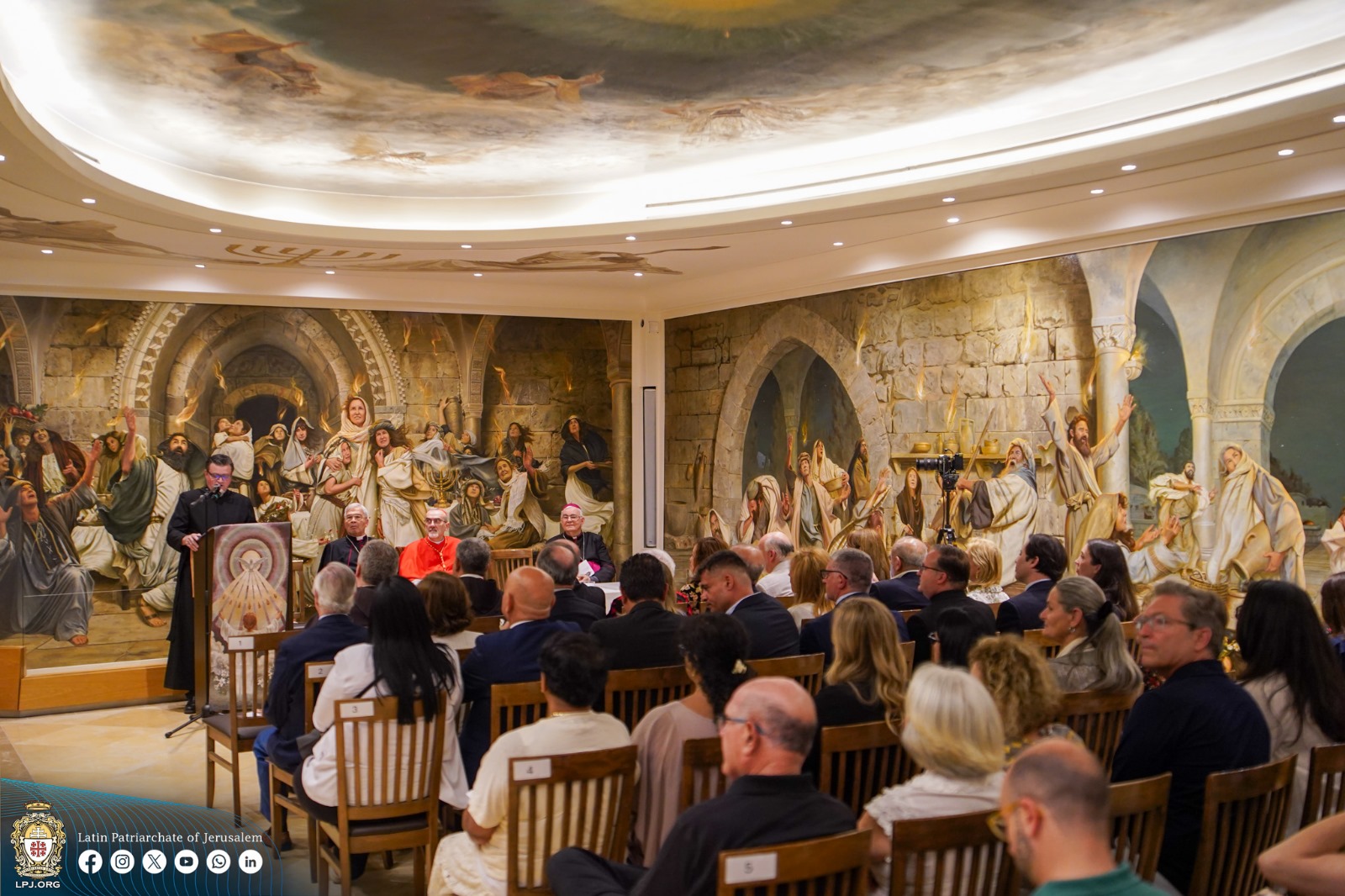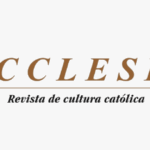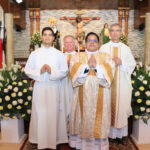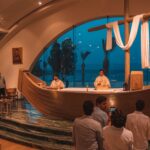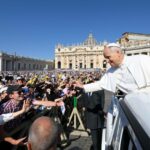On the vigil of the Solemnity of Pentecost, Saturday, June 7, Cardinal Pierbattista Pizzaballa, the Latin Patriarch of Jerusalem, blessed the new area of the center entrusted to the Legion of Christ by Pope Saint John Paul II in 2004. Numerous local lay people and Christian leaders participated in the ceremony. The “Pentecost Room” is a sacred space dedicated to welcoming pilgrims and visitors to encounter the Holy Spirit.
The room was painted by Chilean artist Daniel Cariola. We’re sharing an interview originally published on the Magdala website.
Interview with Daniel Cariola, Artist of the Pentecost Room: “I’d like people to see the good that Christ came to do, that things should be taken seriously”
Daniel Cariola, a Chilean artist known for his famous painting “Encuentro” in Magdala, is the master behind this immersive work. Daniel has over 30 years of experience in fine art painting. Since 2016, he’s been preparing for the Pentecost Room project, researching, praying, and reflecting on this event to help bring it to life.
How has your creative process been for this work?
D: It started with Father Juan’s idea to request, let’s say, as a dream for him, to create the hall with the event of Pentecost, the very origin of the Church. I’m more of an analytical painter than an expressive one, so first I had to thoroughly research the history, that is, what is Pentecost about? From there, Father Juan and I talked on several occasions. Initially, Father Juan came to Chile and we discussed this topic. At first, Father Juan told me some theological things related to this within the Church, and sometimes I would challenge him, and well, in the end, we reached a consensus, and indeed there are things we agreed on, such as that there would not be 12, but 120 people. It wasn’t just the 12. In chapter 1 of the Acts of the Apostles, it mentions that Mary Magdalene and some of the apostles were present. It symbolizes, in some way, I believe it’s a personal point of view, a bit the line that the Lord has, to establish a new kingdom, not with the 12 apostles, because it’s like a multiple of 12, 120, not 10 per family. This creative process had to involve more characters now. I had to involve more characters, but obviously, we had to highlight the main ones, who were the 12 apostles, plus the Virgin Mary, plus some important figures, like Nicodemus, for example.
I also started looking for elements to help me with this, for example, photographing stones, many stones. When I went to Jerusalem with my wife, we would go out to look at stones, to study the architecture a bit, I took thousands of photos. These photos also had to do with textures, with clothes, with people’s actions, everything.
Daniel, how long did it take you to make this work?
D: At first, the deadline was set at a year or a year and a half maximum, but well, we also initially estimated 12, and on top of that, the sky part wasn’t even planned, so it dragged on. Let’s say without knowing a time limit, because you know that when you make a work of art, you give an approximate time, but the truth is that sometimes things don’t turn out that easy.
And in my case?
For example, portraying 120 people, and not just portraits, but full-body in motion. Thinking about folds, shadows, textures, lights, the harmony of colors, the composition. Thinking about the theology of this, what it entails, for example, including a certain character and not others. I practically started in December 2019, the pandemic hit in 2020, then I had to come to Chile, and we’ve skipped a long period here in Chile. In total, we’ve been working for about three years, and I still can’t finish it. I’ve been waiting in Chile for almost a year, and if all goes well, I’ll be there in June to continue.
What are the symbols of that work?
D: Well, it’s full of symbolism. The girls represent the origin of the Church, which is why it’s a woman. The origin of the Church is at Pentecost. She’s a girl because she’s in her beginnings, beginning a new life. And she’s dressed in white for the same reason, because she’s being sanctified, because the Church is the bride of Christ.
Another symbolism is Peter himself. He holds a position in which he is seen as a leader. He’s imposing. He holds the scroll of the Book of Joel in his hand. In the Book of Acts, it says that Peter quoted the Book of Joel, Joel’s prophecy of the promise to the people of Israel. I made Peter with his colorful features, like sea water, like a fisherman, his outfit with a blanket over his shoulder, floating, his arms up to the sky and at his side. I tried to highlight Peter, there with the writing that falls precisely with the impact of this thunder, of this wind that is the Holy Spirit, and falls at the feet of one of the girls. Why? Because the writing falls at the feet of the Church; there it is revealed. The Holy Spirit reveals these things through Peter, and the Bible says that that same day more than 3,000 people were converted. So Peter’s speech was great, very great.
He’s on the second largest wall, the central figure with his arms extended toward heaven. He’s interceding, he’s receiving all power. This figure in the center represents the center of the story, the center in Christ. He is the union between peoples; it’s like a reconciliation that Christ accomplishes in him. Because that’s what Christ ultimately wants: to forgive us.
Daniel, to conclude. What would you like people to take away from entering the Pentecost room?
I would like people to see the good that Christ came to do, that things should be taken seriously. This image is meant to remind us of that essential element, that fire of the Holy Spirit that came to burn away all evil, that came to purify; that sacrifice that Christ also made. Because doing this work has been an enormous sacrifice that has cost me, but I’m happy to have done it, and I hope people take it as a blessing. And for those who want to go on pilgrimage, may it help them remember the plan God has for each one of them.
With this work, Daniel Cariola not only represents a historical event, but also invites spiritual reflection and a deep connection with the essence of Pentecost, leaving a lasting mark on all who experience it. We thank Daniel for this interview and for allowing us to learn more about this work.
To learn more about this work, click here.
About the Pontifical Institute Notre Dame Center
The Notre Dame of Jerusalem Center is a pontifical institute for religious, cultural, and educational purposes. Its administration was entrusted by Pope Saint John Paul II in 2004 to the Congregation of the Legionaries of Christ. It is located in Jerusalem, next to the New Gate of the Old City.
Main Features:
Pilgrim Reception: The center, which was founded in 1888, has a hostel for approximately 300 pilgrims.
Divine Worship: It has a chapel where the sacraments are celebrated daily.
Human Promotion and Formation: It offers human promotion and formation programs for the local population.
Interreligious Dialogue: It promotes initiatives for dialogue and encounter between religions, cultures, and peoples.
Cultural Space: In addition to the chapel, the center houses a museum about the Shroud of Turin, an auditorium, and several conference rooms.
Additional Services: It offers hospitality services, restaurants, and a hospitality school.
In short, the Notre Dame Center in Jerusalem is a multifaceted space that combines welcoming pilgrims with religious, cultural, and educational promotion, as well as interfaith dialogue.
Learn more about the Notre Dame Center.



